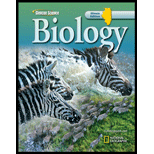
Concept explainers
To compare and contrast:
Two major processes in protein synthesis
Introduction:
The central dogma of biology is that the DNA codes for RNA which guides the synthesis of proteins. Protein synthesis involves two major processes. The first step involves the synthesis of mRNA from DNA in a process called transcription. The next step is translation of codes in mRNA to protein.
Answer to Problem 12STP
The following table compares transcription and translation.
| Transcription | Translation |
| It involves synthesis of RNA from DNA. | It involves synthesis of proteins from mRNA. |
| Code in DNA is converted to complementary code in mRNA. | Codein mRNA is converted to amino acid sequence in protein. |
| It occurs in nucleus of a eukaryotic cell. | It occurs in cytoplasm of a eukaryotic cell. |
| It needs the enzyme RNA polymerase. | It uses ribosomes and various other factors to make a polypeptide chain |
Both the processes need a template to function and both have the same nucleotides; adenine, uracil, cytosine and guanine.
Explanation of Solution
Transcription:
Each DNA molecule consists of two strands. Both the strands have complementary base pairs. During transcription, the two strands of DNA unwind. One strand serves as a template to synthesize new mRNA molecule.
Through transcription, the DNA code is transferred to mRNA.The mRNA transcript is manufactured in a 5’ to 3’ direction adding each new
RNA polymerase is the enzyme that initiates transcription. It binds to promoter sites in DNA, then separates the strands of DNA and helps in synthesizing mRNA using template strand of DNA. It then releases mRNA at stop signal.
In prokaryotes transcription occurs in the cytoplasm of the cell.
In eukaryotes it occurs in the nucleus of the cell.
Translation:
Once the mRNA is synthesized it moves out of the nucleus and enters the cytoplasm where it connects to the ribosome. tRNA molecules act as interpreters of the mRNA codon sequence. An enzyme activates tRNA by attaching a specific amino acid to each tRNA. tRNAs add their amino acids to the polypeptide chain as the mRNA moves through the ribosome one codon at a time. When a stop codon is reached, translation terminates and the polypeptide chain is released.
In prokaryotes translation occurs in the cytoplasm of the cell.
In eukaryotes it occurs on the ribosomes in the cytoplasm of the cell.
Chapter 13 Solutions
Biology Illinois Edition (Glencoe Science)
Additional Science Textbook Solutions
Physics for Scientists and Engineers: A Strategic Approach, Vol. 1 (Chs 1-21) (4th Edition)
Chemistry: Structure and Properties (2nd Edition)
Chemistry & Chemical Reactivity
Genetic Analysis: An Integrated Approach (3rd Edition)
Chemistry: The Central Science (14th Edition)
Applications and Investigations in Earth Science (9th Edition)
- students in a science class investiged the conditions under which corn seeds would germinate most successfully. BAsed on the results which of these factors appears most important for successful corn seed germination.arrow_forwardI want to write the given physician orders in the kardex formarrow_forwardAmino Acid Coclow TABle 3' Gly Phe Leu (G) (F) (L) 3- Val (V) Arg (R) Ser (S) Ala (A) Lys (K) CAG G Glu Asp (E) (D) Ser (S) CCCAGUCAGUCAGUCAG 0204 C U A G C Asn (N) G 4 A AGU C GU (5) AC C UGA A G5 C CUGACUGACUGACUGAC Thr (T) Met (M) lle £€ (1) U 4 G Tyr Σε (Y) U Cys (C) C A G Trp (W) 3' U C A Leu בוט His Pro (P) ££ (H) Gin (Q) Arg 흐름 (R) (L) Start Stop 8. Transcription and Translation Practice: (Video 10-1 and 10-2) A. Below is the sense strand of a DNA gene. Using the sense strand, create the antisense DNA strand and label the 5' and 3' ends. B. Use the antisense strand that you create in part A as a template to create the mRNA transcript of the gene and label the 5' and 3' ends. C. Translate the mRNA you produced in part B into the polypeptide sequence making sure to follow all the rules of translation. 5'-AGCATGACTAATAGTTGTTGAGCTGTC-3' (sense strand) 4arrow_forward
- What is the structure and function of Eukaryotic cells, including their organelles? How are Eukaryotic cells different than Prokaryotic cells, in terms of evolution which form of the cell might have came first? How do Eukaryotic cells become malignant (cancerous)?arrow_forwardWhat are the roles of DNA and proteins inside of the cell? What are the building blocks or molecular components of the DNA and proteins? How are proteins produced within the cell? What connection is there between DNA, proteins, and the cell cycle? What is the relationship between DNA, proteins, and Cancer?arrow_forwardWhy cells go through various types of cell division and how eukaryotic cells control cell growth through the cell cycle control system?arrow_forward
 Human Anatomy & Physiology (11th Edition)BiologyISBN:9780134580999Author:Elaine N. Marieb, Katja N. HoehnPublisher:PEARSON
Human Anatomy & Physiology (11th Edition)BiologyISBN:9780134580999Author:Elaine N. Marieb, Katja N. HoehnPublisher:PEARSON Biology 2eBiologyISBN:9781947172517Author:Matthew Douglas, Jung Choi, Mary Ann ClarkPublisher:OpenStax
Biology 2eBiologyISBN:9781947172517Author:Matthew Douglas, Jung Choi, Mary Ann ClarkPublisher:OpenStax Anatomy & PhysiologyBiologyISBN:9781259398629Author:McKinley, Michael P., O'loughlin, Valerie Dean, Bidle, Theresa StouterPublisher:Mcgraw Hill Education,
Anatomy & PhysiologyBiologyISBN:9781259398629Author:McKinley, Michael P., O'loughlin, Valerie Dean, Bidle, Theresa StouterPublisher:Mcgraw Hill Education, Molecular Biology of the Cell (Sixth Edition)BiologyISBN:9780815344322Author:Bruce Alberts, Alexander D. Johnson, Julian Lewis, David Morgan, Martin Raff, Keith Roberts, Peter WalterPublisher:W. W. Norton & Company
Molecular Biology of the Cell (Sixth Edition)BiologyISBN:9780815344322Author:Bruce Alberts, Alexander D. Johnson, Julian Lewis, David Morgan, Martin Raff, Keith Roberts, Peter WalterPublisher:W. W. Norton & Company Laboratory Manual For Human Anatomy & PhysiologyBiologyISBN:9781260159363Author:Martin, Terry R., Prentice-craver, CynthiaPublisher:McGraw-Hill Publishing Co.
Laboratory Manual For Human Anatomy & PhysiologyBiologyISBN:9781260159363Author:Martin, Terry R., Prentice-craver, CynthiaPublisher:McGraw-Hill Publishing Co. Inquiry Into Life (16th Edition)BiologyISBN:9781260231700Author:Sylvia S. Mader, Michael WindelspechtPublisher:McGraw Hill Education
Inquiry Into Life (16th Edition)BiologyISBN:9781260231700Author:Sylvia S. Mader, Michael WindelspechtPublisher:McGraw Hill Education





